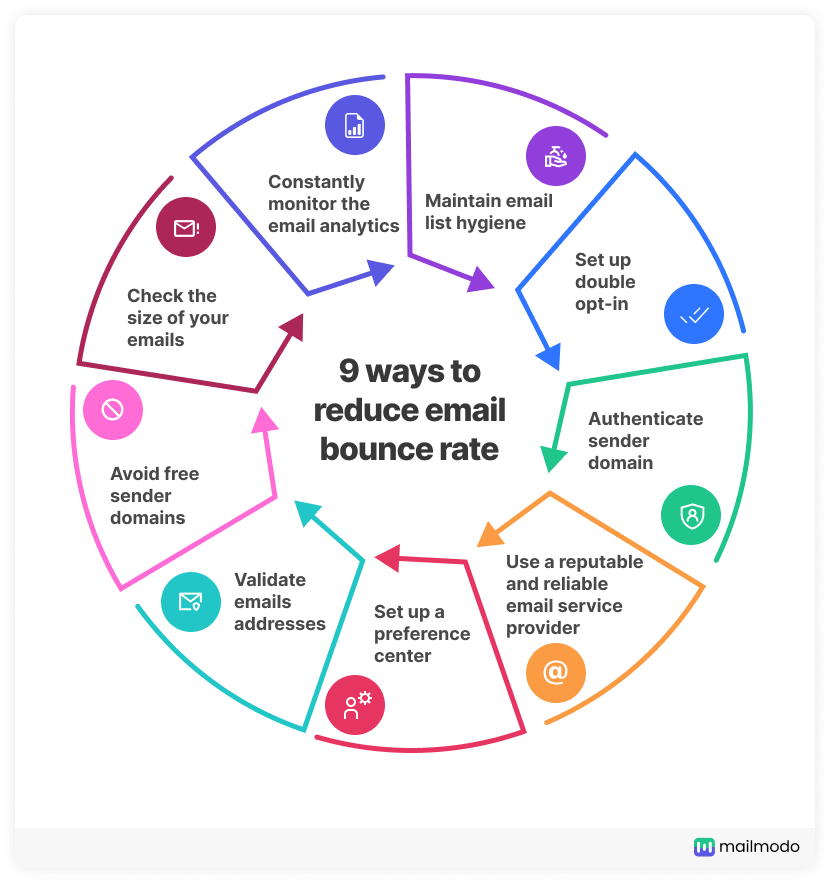Keeping email bounce rates as low as possible is your ticket to higher deliverability.
The subject line email copy will make a difference only when the email reaches your targeted audience. Hence, monitoring your email bounces and keeping them low is crucial for higher returns.
This guide will go over email bounce rate basics and give you 9 useful tactics to help you reduce your bounce rate and get more emails delivered to your subscriber's inbox.
Table of contents
9 ways to reduce email bounce rate
- 1. Maintain email list hygiene
- 2. Set up double opt-in to verify the email authenticity
- 3. Authenticate domain via SPF, DKIM, and DMARC
- 4. Use a reputable and reliable email service provider
- 5. Set up a preference center
- 6. Validate emails using email verification tools
- 7. Avoid free sender domains
- 8. Check the size of your emails
- 9. Constantly monitor the email analytics
What is an email bounce rate?
An email bounce rate is the number of emails bounced from the recipient's server and didn't get delivered. The email bounces due to temporary or permanent issues, including wrong email address, recipient's full inbox, server down, etc.
The recipient's server sends an automated bounce message called a Non-Delivery Report/Receipt (NDR). It contains the details of the particular problem with that email delivery. The recipient's tab of sent marketing emails holds complete information regarding the bounce type and server response.
What causes an email bounce rate?
An email bounces due to many reasons, including:
- Wrong or invalid email address.
- The recipient's email address exists no longer.
- The recipient's server is down, and they couldn't receive the email at the moment.
- The recipient's inbox is full.
- The email content size is too large.
- The recipient's mailbox is not configured correctly.
- The email message does not meet the recipient server's sender requirements.
Two types of email bounces
Email bounces are divided into two categories based on the reason behind the bounces:
- Hard bounce
- Soft bounce
Hard bounces
Hard bounces happen due to permanent problems such as invalid email addresses or non-existent domain names. This is common when users use a temporary or fake email address.
You should use double opt-in to verify the email address and segment users who didn't verify their email addresses. You can also use email verification tools to validate the email ids provided by an individual.
Soft bounces
Soft bounces occur for many temporary reasons, including issues with the recipient's server or full inbox.
To avoid soft bounces, you should try sending emails a few times and if the results are the same, suppress such email addresses.
Related guide: Hard Bounce vs. Soft Bounce: Definition And Best Practices
How to calculate email bounce rate?
You should have the following figures to calculate the email bounce rate:
Total number of bounced emails
Total number of emails sent
Once you have that, use the following formula:
Email bounce rate = ( Number of total emails bounced/Total number of emails sent ) X 100
For instance, if you send 10,000 emails and out of those 2000 emails get bounced, the email bounce rate will be ( 2000 / 10,000 ) X 100 = 20%
What is a good email bounce rate?
The answer, as always, is that it depends.
Each industry has its bounce rate because they target different demographics, geographics, and individuals with diverse interests, jobs, and preferences.
A bounce rate between 0.5 - 1% is considered good as per Mailchimp's industry benchmarks.
It's important to remember that few bounces are normal in a subscriber's lifecycle journey. They change their job titles, move to a different city, and abandon their old email address.
But, a higher bounce rate than the industry average can signal bad email list hygiene practices. To help you out here, we will discuss 9 effective ways to lower your bounce rate and get more emails delivered to recipients' inboxes.
9 ways to reduce email bounce rate

You can take the following steps to decrease the email bounce rate and increase the deliverability of your emails:
1. Maintain email list hygiene
One of the most helpful ways to reduce email bounces is analyzing, cleaning, and maintaining your email list. Here are some of the best practices you should follow to maintain email list hygiene:
Identify and remove bounced email addresses. With Mailmodo, you can put these addresses in a suppression list and avoid sending them emails altogether.
Verifying and validating the existing email addresses using email verification tools or by sending an email to ask users whether it is the right email or not.
Email Marketing Tip:
— Chase Dimond | Email Marketing Nerd 📧 (@ecomchasedimond) May 22, 2022
Don’t forget to suppress subscribers who haven’t opened any of your emails within the last 3-6 months.
A) they’re adding no value to you
B) they’re costing you $
Removing them will help clean your list and reduce what you’re paying your email platform.
Learn email list hygiene best practices in detail.
2. Set up double opt-in to verify the email authenticity
It's always better to verify the users' permission when signing up for your email list. You should set up a double opt-in and ask subscribers to confirm their email address when signing up for your email list. It helps you segment users who confirmed their email addresses from those who didn't. You can simply remove the latter from your email list.
3. Authenticate domain via SPF, DKIM, and DMARC
Your ESP should help you authenticate the domain name as it signals to email clients that you are who you claim to be and are not spamming the inbox. Three major email authentication protocols you should look out for are:
SPF: Ensures that you are sending email from an authentic server
DKIM: Ensures that email content is not tampered with.
DMARC: Takes authoritative action in case SPF/DKIM fails.
4. Use a reputable and reliable email service provider
Ensure that you use a reliable ESP to send email from a reputable IP address. Mailmodo ensures that IP and domain are warmed up to increase your chance of getting delivered to the recipient's inbox.
5. Set up a preference center
Over the subscriber's lifecycle, the changes in their behavior, preferences, interests, job titles, location, etc., are inevitable. You should set up a preference center to navigate such changes. It's a dashboard where you ask subscribers to update or manage their preferences to send them only the relevant and timely emails.
Related guide: How to Create Powerful Preference Center to Retain Your Subscribers
6. Validate emails using email verification tools
Verify and validate the email addresses in your email list using the right email verification tools. Otherwise, getting hit by a hard bounce rate can be high.
These verification tools offer insights into whether the email address is valid and if the recipient's inbox is accepting emails at the moment. Having such insights before sending the email is useful in tackling the issue of hard and soft bounces.
7. Avoid free sender domains
If you're using free email domains such as @gmail.com, your emails might end up in the spam folder. Also, those emails will not pass the DMARC policy check for Yahoo, Gmail, and AOL.
It increases your email bounce rate and spoils your domain reputation. So, use a professional business domain for sending your email campaigns.
8. Check the size of your emails
One reason why email bounce is that the recipient's server refused to let email pass through due to heavy email content. Different email clients allow different file sizes to land in the inbox. In such a scenario, it's important to be familiar with the acceptable file size to reduce your email bounce rate and land in the user's inbox.
9. Constantly monitor the email analytics
Keep an eye over your email analytics, especially email deliverability, as none of the metrics would matter if your emails were not delivered to the recipient's inbox.
Gathering data from different email campaigns and drawing insights can help you identify which email addresses are causing the highest bounces. Remove such emails from your email list to maintain your sender's reputation and email deliverability. Read how SBNRI managed their suppression list with Mailmodo, leading to a 16% increase in open rates.
Conclusion
Even though you get to maintain your bounce rate within the industry standard, the game doesn't stop there. It's just the tip of the iceberg. A lower bounce rate won't be beneficial if your emails are not making it to the recipient's inbox. It means ensuring higher deliverability and lower bounce rate is what you should strive for.
So, we recommend you read out 12 tips to improve your email deliverability and get those opens and click-through rolling.
What you should do next
Hey there, thanks for reading till the end. Here are 3 ways we can help you grow your business:
Talk to an email expert. Need someone to take your email marketing to the next level? Mailmodo’s experts are here for you. Schedule a 30-minute email consultation. Don’t worry, it’s on the house. Book a meet here.
Send emails that bring higher conversions. Mailmodo is an ESP that helps you to create and send app-like interactive emails with forms, carts, calendars, games, and other widgets for higher conversions. Get started for free.
Get smarter with our email resources. Explore all our knowledge base here and learn about email marketing, marketing strategies, best practices, growth hacks, case studies, templates, and more. Access guides here.


